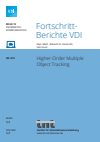Higher-Order Multiple Object Tracking
Zusammenfassung
This dissertation deals with camera-based offline multiple object tracking and explores higher-order data association models. Due to their extensive exploitation of the available information, such models are promising approaches in current research. However, they commonly represent NP-hard optimization problems so that their application in practice is challenging.
The first part of this thesis proposes a binary quadratic program that enables to globally fuse signals within a higher-order data association model. This enables to overcome weaknesses of the individual signals. An approximate solver based on the Frank-Wolfe algorithm is presented and analyzed. Its benefit is demonstrated in two setups: fusion of two detectors and combining signals coming from a video and body-worn inertial measurement units. The second part of this thesis proposes an extension of the disjoint path model by higher-order information and connectivity priors, resulting in a binary linear program. Efficient separation algorithms are proposed and integrated into a cutting-plane algorithm, making it possible for the first time to solve higher-order data association globally in practice.
Contents
1 Intro...
Schlagworte
- Kapitel Ausklappen | EinklappenSeiten
- 1–32 1 Introduction 1–32
- 33–79 2 Fundamentals 33–79
- 130–164 4 Lifted Disjoint Paths 130–164
- 165–171 5 Conclusions 165–171
- 172–196 Bibliography 172–196


